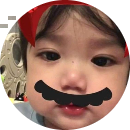Giải phương trình: 5 – (x – 6) = 4.(3 – 2x)

Những câu hỏi liên quan
3.15 giải các phương trình sau :
a) ( x - 6 ) ( 2x - 5 ) ( 3x + 9 ) = 0
b) 2x( x - 3 ) + 5( x - 3 ) = 0
c) ( x^2 - 4 ) - ( x - 2 ) ( 3 - 2x ) =0
3.16 tìm m để phương trình sau có nghiệm :
x=-7 ( 2m - 5 )x - 2m^2 + 8
3.17 giải các phương trình sau :
a) ( 2x - 1 )^2 - ( 2x + 1 ) = 0
\(a,\left(x-6\right)\left(2x-5\right)\left(3x+9\right)=0\Leftrightarrow\left[{}\begin{matrix}x-6=0\Leftrightarrow x=6\\2x-5=0\Leftrightarrow x=\dfrac{5}{2}\\3x+9=0\Leftrightarrow x=-3\end{matrix}\right.\)
\(b,2x\left(x-3\right)+5\left(x-3\right)=0\Leftrightarrow\left(2x+5\right)\left(x-3\right)=0\Leftrightarrow\left[{}\begin{matrix}x-3=0\Leftrightarrow x=3\\2x+5=0\Leftrightarrow x=-\dfrac{5}{2}\end{matrix}\right.\)
\(c,x^2-4-\left(x-2\right)\left(3-2x\right)=0\Leftrightarrow\left(x-2\right)\left(x+2\right)-\left(x-2\right)\left(3-2x\right)=0\Leftrightarrow\left(x-2\right)\left(x+2-3+2x\right)=0\Leftrightarrow\left[{}\begin{matrix}x=2\\x=\dfrac{1}{3}\end{matrix}\right.\)
\(x=-7\left(2m-5\right)x-2m^2+8\Leftrightarrow x+7\left(2m-5\right)=8-2m^2\Leftrightarrow x\left(14m-34\right)=8-2m^2\)
\(ycđb\Leftrightarrow14m-34\ne0\Leftrightarrow m\ne\dfrac{34}{14}\)\(\Rightarrow x=\dfrac{8-2m^2}{14m-34}\)
\(3.17\Leftrightarrow4x^2-4x+1-2x-1=0\Leftrightarrow4x^2-6x=0\Leftrightarrow x\left(4x-6\right)=0\Leftrightarrow\left[{}\begin{matrix}x=0\\x=\dfrac{3}{2}\end{matrix}\right.\)
Đúng 2
Bình luận (0)
3.15:
a, \(\Leftrightarrow\left\{{}\begin{matrix}x-6=0\\2x-5=0\\3x+9=0\end{matrix}\right.\Leftrightarrow\left\{{}\begin{matrix}x=6\\x=\dfrac{5}{2}\\x=-\dfrac{9}{3}=-3\end{matrix}\right.\)
b, \(\Leftrightarrow\left(x-3\right)\left(2x+5\right)=0\)
\(\Leftrightarrow\left\{{}\begin{matrix}x-3=0\\2x+5=0\end{matrix}\right.\Leftrightarrow\left\{{}\begin{matrix}x=3\\x=-\dfrac{5}{2}\end{matrix}\right.\)
c, \(\Leftrightarrow\left(x-2\right)\left(x+2\right)-\left(x-2\right)\left(3-2x\right)=0\)
\(\Leftrightarrow\left(x-2\right)\left(x+2-3+2x\right)=0\)
\(\Leftrightarrow\left\{{}\begin{matrix}x-2=0\\3x-1=0\end{matrix}\right.\Leftrightarrow\left\{{}\begin{matrix}x=2\\x=\dfrac{1}{3}\end{matrix}\right.\)
3.16
\(\Leftrightarrow\left(2m-5\right).-7-2m^2+8=0\)
\(\Leftrightarrow-14m+35-2m^2+8=0\)
\(\Leftrightarrow-14m-2m^2+43=0\)
\(\Leftrightarrow-2\left(7m+m^2\right)=-43\)
\(\Leftrightarrow m\left(7-m\right)=\dfrac{43}{2}\)
\(\Leftrightarrow\dfrac{m\left(7-m\right)}{1}-\dfrac{43}{2}=0\)
\(\Leftrightarrow\dfrac{14m-2m^2}{2}-\dfrac{43}{2}=0\)
pt vô nghiệm
Đúng 1
Bình luận (0)
Bàil: Giải phương trình sau a) 2x - 3 3 - x b) 7x - 4 3x + 12 c) 3x - 6 + x 9 - x d) 10x - 12 - 3x 6 + x Bài 2: Giải bất phương trình sau và biểu diễn tập nghiệm trên trục số: a) 4x + 6 2x - 2 b) 3x + 15 0 c) 3x - 3 x + 5 d) x - 4 - 2x + 5 Bài3: a) Một người đi xe máy từ 4 đến B với vận tốc 25km/h. Lúc về người đó đi với vận tốc 30km/h, nên thời gian về ít hơn thời gian đi là 20 phút. Tính AB ? b) Một người đi xe đạp từ A đến B với vận tốc 15 km/h. Sau đó quay về từ B về A với vận tốc 12...
Đọc tiếp
Bàil: Giải phương trình sau a) 2x - 3 = 3 - x b) 7x - 4 = 3x + 12 c) 3x - 6 + x = 9 - x d) 10x - 12 - 3x = 6 + x Bài 2: Giải bất phương trình sau và biểu diễn tập nghiệm trên trục số: a) 4x + 6 <= 2x - 2 b) 3x + 15 < 0 c) 3x - 3 > x + 5 d) x - 4 > - 2x + 5 Bài3: a) Một người đi xe máy từ 4 đến B với vận tốc 25km/h. Lúc về người đó đi với vận tốc 30km/h, nên thời gian về ít hơn thời gian đi là 20 phút. Tính AB ? b) Một người đi xe đạp từ A đến B với vận tốc 15 km/h. Sau đó quay về từ B về A với vận tốc 12 km/h. Cả đi lẫn về hết 4 giờ 30 phút. Tính quãng đường 4B Bài 4: Cho tam giác ABC vuông tại A với AB = 3cm AC= 4cm vẽ đường cao AE. a) Chứng minh rằng AABC đồng dạng với AEBA. b) Tia phân giác của góc ABC cắt AC tại F. Tính BF Bài 5: Cho tam giác ABC có AC = 8cm, AC = 16cm Gọi D và E là hai điểm lần lượt trên cạnh AB và AC sao cho BD = 2cm CE = 13cm Chứng minh rằng a. AAEB AADC b. AED= ABC, cho DE = 5cm Tính BC? C. AE AC AD AB
1:
a: =>3x=6
=>x=2
b: =>4x=16
=>x=4
c: =>4x-6=9-x
=>5x=15
=>x=3
d: =>7x-12=x+6
=>6x=18
=>x=3
2:
a: =>2x<=-8
=>x<=-4
b: =>x+5<0
=>x<-5
c: =>2x>8
=>x>4
Đúng 0
Bình luận (0)
Giải các phương trình sau a) 5-(x-6)=4(3-2x); b) 3 - x ( 1 - 3x)=5(1-2x); c) (x-3)(x+4)-2(3x-2)= (x-4)²
`5-(x-6)=4(3-2x)`
`<=>5-x+6-4(3-2x)=0`
`<=> 5-x+6-12 +8x=0`
`<=> 7x -1=0`
`<=> 7x=1`
`<=>x=1/7`
Vậy pt đã cho có nghiệm `x=1/7`
__
`3-x(1-3x) =5(1-2x)`
`<=> 3-x+3x^2=5-10x`
`<=> 3-x+3x^2-5+10x=0`
`<=> 3x^2 +9x-2=0`
\(\Leftrightarrow\left[{}\begin{matrix}x=\dfrac{-9+\sqrt{105}}{6}\\x=\dfrac{-9-\sqrt{105}}{6}\end{matrix}\right.\)
Vậy pt đã cho có tập nghiệm \(S=\left\{\dfrac{-9+\sqrt{105}}{6};\dfrac{-9-\sqrt{106}}{5}\right\}\)
__
`(x-3)(x+4) -2(3x-2)=(x-4)^2`
`<=>x^2+4x-3x-12- 6x +4 =x^2 -8x+16`
`<=>x^2-5x-8=x^2-8x+16`
`<=> x^2 -5x-8-x^2+8x-16=0`
`<=> 3x-24=0`
`<=>3x=24`
`<=>x=8`
Vậy pt đã cho có nghiệm `x=8`
Đúng 3
Bình luận (5)
a) 5-(x-6)=4(3-2x)
=> 5 – x + 6 = 12 – 8x
=> -x + 8x = 12 – 5 – 6
=> 7x = 1
=> x=1/7
Vậy phương trình có nghiệm x=1/7
b) 3 - x ( 1 - 3x)=5(1-2x)
=> 3-x+3x^2=5-10x
=> 3x^2+9x-2= 0
0=105
=> x =\(\dfrac{-9-\sqrt{105}}{6}\)
Đúng 0
Bình luận (0)
Giải các phương trình sau 5 – (6 – x) = 4(3 – 2x)
5 – (6 – x) = 4(3 – 2x)
⇔ 5 – 6 + x = 12 – 8x
⇔ x + 8x = 12 – 5 + 6
⇔ 9x = 13
⇔ x = 13/9
Vậy phương trình có một nghiệm x = 13/9.
Đúng 0
Bình luận (0)
giải phương trình a)2x-7=11x+11
b)2011x-4=x+6
c)5(2x-3)-2(3x-5)=0
a) 2x-7=11x+11
<=> 2x-11x=11+7
<=> -9x=17
<=> x= -17/9
b) 2011x -4 =x+6
<=> 2011x-x=6+4
<=> 2010x=10
<=> x=10/2010
<=> x=1/201
c) 5(2x-3)-2(3x-5)=0
<=> 10x-15-6x+10=0
<=> 10x-6x=15-10
<=>4x=5
<=> x=5/4
Đúng 0
Bình luận (0)
\(\dfrac{x-3}{4}-\dfrac{5-2x}{6}=\dfrac{x}{2}+\dfrac{5}{12}\)
giải các phương trình sau
\(PT.\Rightarrow3x-9-\left(10-4x\right)=6x+5.\)
\(\Leftrightarrow3x-9-10+4x=6x+5.\\ \Leftrightarrow7x-19=6x+5.\\ \Leftrightarrow x=24.\)
Đúng 1
Bình luận (0)
Giải các phương trình sau. 2x-1=2-x ; x-5x-1/6=8-3x/4. ; x/3 - 2x+1/2=x/6 - x ; (2x-5)(x+3)=0. ; (1-7)(2+x)=0
Bạn cần viết đề bằng công thức toán (biểu tượng $\sum$ góc trái khung soạn thảo) đẻ được hỗ trợ tốt hơn. Viết như thế kia rất khó đọc => khả năng bị bỏ qua bài cao.
Đúng 0
Bình luận (0)
a: =>3x=3
=>x=1
b: =>12x-2(5x-1)=3(8-3x)
=>12x-10x+2=24-9x
=>2x+2=24-9x
=>11x=22
=>x=2
c: =>2x-3(2x+1)=x-6x
=>-5x=2x-6x-3=-4x-3
=>-x=-3
=>x=3
d: =>2x-5=0 hoặc x+3=0
=>x=5/2 hoặc x=-3
e: =>x+2=0
=>x=-2
Đúng 0
Bình luận (0)
giải bất phương trình sau f(x)=(3x-4)(2x-3)/(x2-5x+6)(5-x)>0
\(f\left(x\right)=\dfrac{\left(3x-4\right)\left(2x-3\right)}{\left(x^2-5x+6\right)\left(5-x\right)}>0\)
\(\Leftrightarrow\dfrac{\left(3x-4\right)\left(2x-3\right)}{\left(x-2\right)\left(x-3\right)\left(5-x\right)}>0\)
Bảng xét dấu:

Từ bảng xét dấu ta thấy nghiệm của BPT là: \(\left[{}\begin{matrix}x< 5\\\dfrac{3}{2}< x< 2\\3< x< 5\end{matrix}\right.\)
Đúng 0
Bình luận (0)
giải phương trình sau
1/ 2x( x+3) - 6 (x-3) =0
2/ 2x^2( 2x+3) +(2x+3) =0
3/ (x-2) (x+1) -(x-2) 4x =0
4/ 2x ( x-5) -3x +15=0
5/ 3x(x+4) -2x-8 =0
6/ x^2 (2x-6) + 2x -6 =0
1: Ta có: \(2x\left(x+3\right)-6\left(x-3\right)=0\)
\(\Leftrightarrow2x^2+6x-6x+18=0\)
\(\Leftrightarrow2x^2+18=0\left(loại\right)\)
2: Ta có: \(2x^2\left(2x+3\right)+\left(2x+3\right)=0\)
\(\Leftrightarrow2x+3=0\)
hay \(x=-\dfrac{3}{2}\)
3: Ta có: \(\left(x-2\right)\left(x+1\right)-4x\left(x-2\right)=0\)
\(\Leftrightarrow\left(x-2\right)\left(1-3x\right)=0\)
\(\Leftrightarrow\left[{}\begin{matrix}x=2\\x=\dfrac{1}{3}\end{matrix}\right.\)
Đúng 1
Bình luận (0)
4: Ta có: \(2x\left(x-5\right)-3x+15=0\)
\(\Leftrightarrow\left(x-5\right)\left(2x-3\right)=0\)
\(\Leftrightarrow\left[{}\begin{matrix}x=5\\x=\dfrac{3}{2}\end{matrix}\right.\)
5: Ta có: \(3x\left(x+4\right)-2x-8=0\)
\(\Leftrightarrow\left(x+4\right)\left(3x-2\right)=0\)
\(\Leftrightarrow\left[{}\begin{matrix}x=-4\\x=\dfrac{2}{3}\end{matrix}\right.\)
6: Ta có: \(x^2\left(2x-6\right)+2x-6=0\)
\(\Leftrightarrow2x-6=0\)
hay x=3
Đúng 1
Bình luận (0)
























